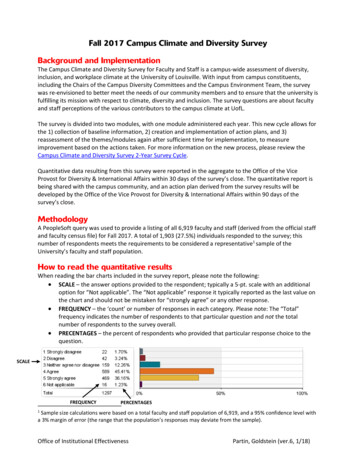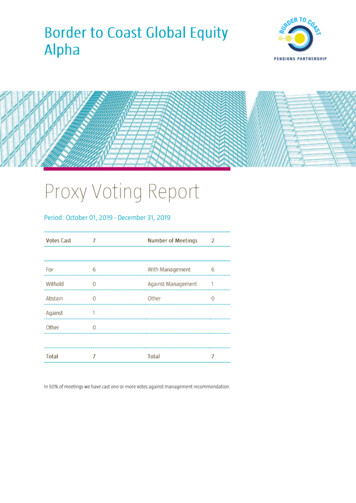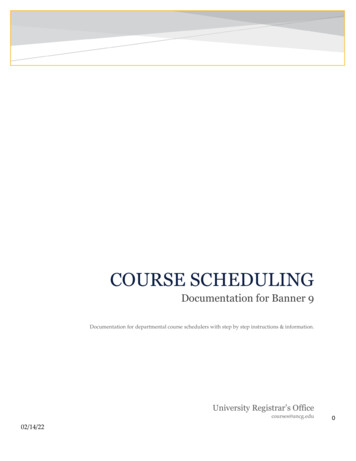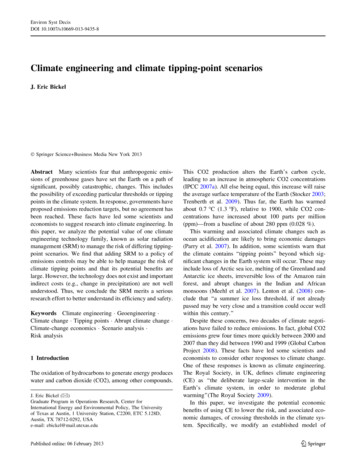
Transcription
Fall 2017 Campus Climate and Diversity SurveyBackground and ImplementationThe Campus Climate and Diversity Survey for Faculty and Staff is a campus-wide assessment of diversity,inclusion, and workplace climate at the University of Louisville. With input from campus constituents,including the Chairs of the Campus Diversity Committees and the Campus Environment Team, the surveywas re-envisioned to better meet the needs of our community members and to ensure that the university isfulfilling its mission with respect to climate, diversity and inclusion. The survey questions are about facultyand staff perceptions of the various contributors to the campus climate at UofL.The survey is divided into two modules, with one module administered each year. This new cycle allows forthe 1) collection of baseline information, 2) creation and implementation of action plans, and 3)reassessment of the themes/modules again after sufficient time for implementation, to measureimprovement based on the actions taken. For more information on the new process, please review theCampus Climate and Diversity Survey 2-Year Survey Cycle.Quantitative data resulting from this survey were reported in the aggregate to the Office of the ViceProvost for Diversity & International Affairs within 30 days of the survey’s close. The quantitative report isbeing shared with the campus community, and an action plan derived from the survey results will bedeveloped by the Office of the Vice Provost for Diversity & International Affairs within 90 days of thesurvey’s close.MethodologyA PeopleSoft query was used to provide a listing of all 6,919 faculty and staff (derived from the official staffand faculty census file) for Fall 2017. A total of 1,903 (27.5%) individuals responded to the survey; thisnumber of respondents meets the requirements to be considered a representative1 sample of theUniversity’s faculty and staff population.How to read the quantitative resultsWhen reading the bar charts included in the survey report, please note the following: SCALE – the answer options provided to the respondent; typically a 5-pt. scale with an additionaloption for “Not applicable”. The “Not applicable” response it typically reported as the last value onthe chart and should not be mistaken for “strongly agree” or any other response. FREQUENCY – the ‘count’ or number of responses in each category. Please note: The “Total”frequency indicates the number of respondents to that particular question and not the totalnumber of respondents to the survey overall. PRECENTAGES – the percent of respondents who provided that particular response choice to thequestion.SCALEFREQUENCYPERCENTAGES1Sample size calculations were based on a total faculty and staff population of 6,919, and a 95% confidence level witha 3% margin of error (the range that the population’s responses may deviate from the sample).Office of Institutional EffectivenessPartin, Goldstein (ver.6, 1/18)
Helpful hints for reviewing the quantitative reportIt’s best to read all the results to get the overall picture before developing a critique about the data.Reading all of the results to see all views on the topic helps to create a full understanding. Otherwise, youcan miss something important or begin to form an unintended bias.It’s important to pay attention to the percentage of people who agree/strongly agree and those whodisagree/strongly disagree – even though 50% of respondents may feel one way, 25% (or one-fourth of therespondents) may feel strongly another way, and that might be worth noting.Once you have gone through all of the results, some questions you might consider: Do you notice any patterns in how people are responding? What are the most popular responses among the respondents? Is there anything you see that is surprising?Other resourcesPlease also feel free to review the report from the most recent past survey to compare responses. Do notethat changes were made to the format for the 2017 survey, so comparison to the 2014 survey will not beone-for-one:2014 Campus Climate and Diversity SurveyAfter reviewing the survey results, we would appreciate your insights on the data. Please share yourthoughts and ideas through the Climate and Diversity Survey Suggestion Form.Request for participationIf you would like to participate in a topical focus group, please provide your name and contact information.Office of Institutional EffectivenessPartin, Goldstein (ver.6, 1/18)
Fall 2017 Campus Climate and Diversity SurveyFall 2017 Campus Climate and Diversity SurveyProject Audience 6919Responses Received 1903Response Ratio 27.50%
What is your primary role at UofL?If applicable, what is your secondary role at UofL?On which campus do you spend most of your time?2/46
How frequently (if ever) during the past year have you heard aninsensitive or disparaging remark or observed discriminatory behavioron campus directed at the following groups?1. Gay, lesbian or bisexual people2. First generation college students3. International students or faculty/staff4. Men5. Military personnel or veterans3/46
How frequently (if ever) during the past year have you heard an insensitive ordisparaging remark or observed discriminatory behavior on campus directed at thefollowing groups? (continued)6. Non-traditional students (students over the age of 25)7. Transgender, gender nonconforming, or non-binary people8. People of a particular racial or ethnic background9. People of a particular religious background10. People perceived as “too young”4/46
How frequently (if ever) during the past year have you heard an insensitive ordisparaging remark or observed discriminatory behavior on campus directed at thefollowing groups? (continued)11. People perceived as “too old”12. People with a disability13. People who are low-income14. WomenThinking about UofL as an institution, rate how empowered variousgroups are at UofL.1. How empowered are people who are gay, lesbian or bisexual at UofL?5/46
2. How empowered are people who are first generation college students at UofL?3. How empowered are international students or faculty/staff at UofL?4. How empowered are men at UofL?5. How empowered are military personnel or veterans at UofL?6. How empowered are non-traditional students (students over the age of 25) at UofL?7. How empowered are people who are transgender, gender nonconforming, or non-binary at UofL?8. How empowered are people of differing racial or ethnic backgrounds at UofL?6/46
Thinking about UofL as an institution, rate how empowered various groups are at UofL.(continued)9. How empowered are people of different religious groups at UofL?10. How empowered are people who are perceived as “too young” at UofL?11. How empowered are people who are perceived as “too old” at UofL?12. How empowered are people with a disability at UofL?13. How empowered are people who are low-income at UofL?14. How empowered are women at UofL?7/46
Thinking about UofL as an institution, rate how socially integratedvarious groups are at UofL.1. How socially integrated are people who are gay, lesbian or bisexual at UofL?2. How socially integrated are people who are first generation college students at UofL?3. How socially integrated are International students or faculty/staff at UofL?4. How socially integrated are men at UofL?5. How socially integrated are military personnel or veterans at UofL?8/46
Thinking about UofL as an institution, rate how socially integrated various groups are atUofL. (continued)6. How socially integrated are non-traditional students (students over the age of 25) at UofL?7. How socially integrated are people who are transgender, gender nonconforming, or non-binary atUofL?8. ow socially integrated are people of differing racial or ethnic backgrounds at UofL?9. How socially integrated are people of differing religious groups at UofL?10. How socially integrated are people who are perceived as “too young” at UofL?9/46
Thinking about UofL as an institution, rate how socially integrated various groups are atUofL. (continued)11. How socially integrated are people who are perceived as “too old” at UofL?12. How socially integrated are people with disabilities at UofL?13. How socially integrated are people who are low-income at UofL?14. How socially integrated are women at UofL?10/46
Read each of the following statements and indicate your level ofagreement.1. UofL has done a good job supporting diversity.2. I believe that learning about people from a variety of different cultures is an important part of my workenvironment.3. UofL has a good image.4. Overall, I am welcomed and encouraged at UofL.5. UofL practices affirmative action in hiring and promotion.11/46
Read each of the following statements and indicate your level of agreement. (continued)6. UofL provides an open environment for the free expression of all ideas, beliefs, and opinions.7. The campus has a welcoming culture that embraces everyone.8. UofL is accessible to people with disabilities.9. I feel that I belong at UofL.Thinking about the school/college or vice president/provost unit inwhich you work, read each of the following statements and indicateyour level of agreement.1. From my perspective, people are treated equally regardless of race/ethnicity in my area12/46
2. From my perspective, people are treated equally regardless of gender identity in my area3. From my perspective, people are treated equally regardless of age in my area4. From my perspective, people are treated equally regardless of religious beliefs in my area5. From my perspective, people are treated equally regardless of sexual orientation in my area6. Appropriate accommodations are made to meet the needs of staff and students with disabilities in myarea13/46
Thinking about the school/college or vice president/provost unit inwhich you work, read each of the following statements and indicateyour level of agreement.1. The leadership of my area adheres to university policies against gender harassment2. The leadership of my area adheres to university policies regarding gender equality3. The leadership of my area adheres to university policies against harassment based on sexualorientation4. The leadership of my area encourages the recruitment and retention of minority employees5. The leadership of my area adheres to university policies against racial/ethnic harassment14/46
Thinking about the school/college or vice president/provost unit inwhich you work, read each of the following statements and indicateyour level of agreement.1. My area encourages diverse perspectives in decision-making2. Behaviors which are offensive, malicious, or insulting are not accepted in my area3. In my area, there are opportunities for me to engage in service outside of the university4. In my area, there are opportunities for me to engage in service within the university5. In my area, I receive support for working with diverse groups and working in cross-cultural situations15/46
Thinking about the school/college or vice president/provost unit in which you work,read each of the following statements and indicate your level of agreement. (continued)6. My area has created a climate where complaints of unfairness are taken seriously7. The diversity climate in my area can be described as harmonious/pleasant8. My area has created a climate for open discussions and dialogue about issues related to diversitywithout fear of retaliation9. My area promotes inclusiveness for individual differences10. I feel that I am an integral/important part of my area16/46
Classroom/Learning Environment: Read each of the followingstatements and indicate your level of agreement.1. When appropriate, I present the contributions of racial and ethnic minorities in my courses2. When appropriate, I present the contributions of women in my courses3. When appropriate, I present the contributions of other historically marginalized groups4. When appropriate, I present diverse perspectives, ideas, and ideologies in my courses17/46
From the list below, please select any diversity training topics in whichyou would be interested:From the list below, please select the best delivery of diversity training:18/46
To what extent (if any) have you personally experienced any of thefollowing directed towards you at UofL:1. Bullying (a pattern of repeated unwanted deliberate or subconscious behavior that may directly orindirectly cause reasonable fear of or actual physical, emotional, and/or psychological harm to anotherindividual. Bullying is not characterized by a single occurrence, but rather, by repeated incidents of ahostile nature. Workplace bullying often involves an abuse or misuse of power. Bullying does not includethe evaluation of one's work performance or the assignment of a workload within reasonable parametersof the individual's job description and capabilities. May include some or all of the following components:verbal, written, gestural, social, or physical.)2. Gender discrimination3. Harassment (has a strong physical component, e.g. contact and touch in all its forms, intrusion intopersonal space and possessions, damage to possessions including a person’s work, etc. Can be basedon a target’s gender, race, disability, etc.)4. Spoken to profanely (cursing or obscene language)19/46
To what extent (if any) have you personally experienced any of the following directedtowards you at UofL: (continued)5. Racial tension6. Exploitation as an employee (the action or fact of treating someone unfairly in order to benefit fromtheir work)7. Lack of professionalism (inappropriate conduct for the work environment)20/46
I feel valued by:1. Faculty2. My co-workers3. My supervisor or chair4. Staff members5. Students21/46
I feel valued by: (continued)6. University-wide administrationRead each of the following statements and indicate your level ofagreement.1. I am rarely, if ever, asked to perform duties outside of my job description2. I feel safe on campus3. The campus grounds and facilities are well maintained4. I have the proper equipment, supplies, and instruments necessary to perform my job effectively22/46
Read each of the following statements and indicate your level of agreement. (continued)5. I believe that working conditions at UofL are satisfactory6. My department is adequately staffed to cover the regular workload7. Regardless of the current climate, I feel I have job security8. My job makes good use of my skills and abilities23/46
Read each of the following statements and indicate your level of agreement. (continued)9. I am encouraged to offer suggestions10. I am encouraged to be innovative in my teaching or my workRead each of the following statements and indicate your level ofagreement.1. Co-workers in my department work well together as a team2. Other departments are willing to collaborate with me to help me do my job3. My job duties are clearly defined24/46
Read each of the following statements and indicate your level ofagreement.1. Faculty are involved in decisions related to academics and the curriculum2. The role of faculty in shared governance is clearly stated and recognized3. I am satisfied with the role Faculty Senate plays in decision-making at UofL4. I am satisfied with the Faculty Senate representation of my interests at UofL25/46
I feel valued by UofL for my:1. Research and scholarship2. Service to the university3. Service to the community4. Teaching5. Mentoring of students26/46
Read each of the following statements and indicate your level ofagreement.1. I am invited to participate in faculty meetings.2. I am respected by full-time faculty in my department.3. The classroom(s) and/or lab space assigned to me enables me to teach effectively.4. The office space assigned to me is adequate for me to meet with students.27/46
Read each of the following statements and indicate your level of agreement. (continued)5. I am satisfied with the amount of notice I receive when the courses I teach are scheduled or changed.6. I am satisfied with the number of courses I am offered to teach.7. I am satisfied with the support I receive from IT.28/46
How frequently do you participate in the following activities?1. Serve on university committees2. Advise students3. Attend UofL events4. Attend department faculty meetings5. Attend other department functions29/46
How frequently do you participate in the following activities?1. Serve on university committees2. Attend UofL events3. Attend unit/department staff meetings4. Attend other unit/department functionsRead each of the following statements and indicate your level ofagreement.1. Staff have a voice in the direction of UofL.30/46
2. I am satisfied with the role Staff Senate plays in decision-making at UofL.3. I am satisfied with the Staff Senate representation of my interests at UofL.4. I feel valued by UofL for my service to the community.5. I feel valued by UofL for my service to the university.6. I am allowed to participate on university committees without it being charged to my leave time.31/46
7. I am encouraged to prepare for promotional opportunities (e.g. attend training, take courses, pursue adegree in order to have the credentials to apply for promotional opportunities when they come along.)Read each of the following statements and indicate your level ofagreement.1. I am invited to participate in unit/department meetings.2. I am respected by full-time staff in my unit/department.3. The office or workspace assigned to me is adequate for me to do my job.4. I am satisfied with the amount of notice I receive when my workload is changed.32/46
Read each of the following statements and indicate your level ofagreement.1. It is easy to balance the needs of work and family.2. There are adequate childcare facilities on campus and in the surrounding area.3. My supervisor or chair is understanding of family situations that require me to put my work on hold(such as illnesses, emergencies, death).4. UofL's policies and procedures help me to balance work life and home life.Please describe your current feeling of balance between your work lifeand your home life.33/46
Thinking back over the past year, how many times have you had to:1. Miss something at work due to home life concerns/responsibilities2. Miss something at home due to work life concerns/responsibilitiesRead each of the following statements and indicate your level ofagreement.1. The environment at UofL supports a balance between work life and home life2. My supervisor/department chair understands the importance of maintaining a balance between worklife and home life3. My colleagues understand the importance of maintaining a balance between work life and home life34/46
4. Opportunities for work/home balance are equally available to all employees5. I rarely, if ever, have to make hard decisions between work and home obligations6. Supporting a work/home life balance should be a priority for UofLPlease answer the following questions about flexible work schedules:1. I currently work a flexible schedule2. I would like to work a flexible schedule3. A flexible schedule should be available to all employees35/46
4. A flexible schedule is available to all employees5. I would have a better balance of work/home with a flexible schedule6. I would be more efficient at my job with a flexible schedule7. I would take advantage of a flexible schedule if offered to meIf the University were to institute a telecommunication policy (i.e.working remotely from home, making use of the internet, email, andtelephone), how likely would you be to take advantage of it?36/46
Read each of the following statements and indicate your level ofagreement.1. The pace of the work at UofL enables me to do a good job2. The amount of work I’m asked to do is reasonable3. UofL has reasonable expectations of its employees4. My job does not cause unreasonable amounts of stress in my life5. My department has the staff necessary to get the job done37/46
6. Tasks are appropriately redistributed when a staff member is away on family or medical leave so thatthe workload doesn’t overburden one person7. I have the resources I need to do my job wellHow often do you find yourself working:1. During your lunch hour2. At work before your usual work hours3. At work after your usual work hours38/46
How often do you find yourself working: (continued)4. At home before your usual work hours5. At home after your usual work hours6. During vacationDo you typically take breaks during your workday?39/46
Which of the following contributes to your lack of regular breaks duringthe day?1. Pressure to get work done2. I like to eat at my desk3. I feel that chatting with others during work takes up my “break” time4. I need to catch up on work5. Lack of staffing requires me to do more work6. No one else in my department takes breaks7. I just don’t want to40/46
Would you take more breaks if you were encouraged to do so?Please identify the family care needs you have now or anticipate1. Childcare for infant/toddler2. Childcare for preschooler3. After school care for school-aged child4. In-home adult care5. Respite care (temporary institutional care of a dependent elderly, ill, or handicapped person, providingrelief for their usual caregivers)6. Assistance for elderly or disabled relative (local)41/46
6. Assistance for elderly or disabled relative (local)7. Assistance for elderly or disabled relative (long distance)What shift do you work most often?As a part-time faculty member or adjunct, which of the following bestdescribes your situation?OptionsScore Count PercentageI have recently retired or am in the process of retiring from full-time employment165.94%I am an aspiring academic finishing or recently finished the terminal degree in my fieldand teach part-time21918.81%I am already an expert or professional, have full-time employment elsewhere and teachpart-time33231.68%I am a freelancer and I teach part-time in addition to other employment41817.82%Other, please specify:52625.74%What is your current gender identity?42/46
Would you be comfortable with gender identity being an optionaldemographic variable collected and maintained by the University?Which best describes your ethnic background?What is your sexual orientation?Would you be comfortable with sexual orientation being an optionaldemographic variable collected and maintained by the University?Do you have a disability?43/46
How would you categorize your disability or disabilities?Are you a veteran or currently serving in the military?How long have you worked at UofL?How much longer do you anticipate working at UofL?44/46
What is the highest level of education you have completed?Which of the following best describes your family status?Read each of the following statements and indicate your level ofagreement.1. I am proud to be part of UofL.2. I would recommend UofL as a place of employment.3. I would want my family and friends to attend UofL.45/46
Read each of the following statements and indicate your level of agreement. (continued)4. I am satisfied with my job.5. Overall, UofL is a good place to work.Overall, how satisfied are you with the climate at UofL?46/46
Please also feel free to review the report from the most recent past survey to compare responses. Do note that changes were made to the format for the 2017 survey, so comparison to the 2014 survey will not be one-for-one: 2014 Campus Climate and Diversity Survey After reviewing the survey results, we would appreciate your insights on the data.











